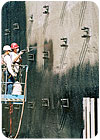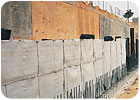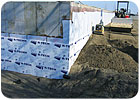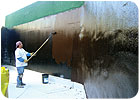
Liquid-applied waterproofing systems include Carlisle Coatings & Waterproofing’s Barritech VP, which provides a continuous, monolithic air and water barrier. (Photo courtesy of Carlisle Coatings & Waterproofing.)
Proper foundation waterproofing is critical to the success of a structure. Due to the potential problems associated with leaking foundations, it is imperative that it is completed properly the first time. A leaking foundation can contribute to damage of the interior components - such as flashings, equipment, walls and floors - and could contribute to long-term structural degradation. Concrete and steel imbedded in the concrete can decay and corrode over time when they are exposed to the continual presence of moisture. The foundation waterproofing must protect the exterior of the structure and the interior components.
Design of foundation waterproofing should follow the construction sequence. The designer must include procedures and responsibilities of all associated trades in the waterproofing process. Responsibility by trade should be clearly defined in the design documents to avoid disputes that may arise during the construction phase. A typical foundation project includes members of several trades working simultaneously. These trades include waterproofers, concrete wall builders, excavators, backfillers and, in some cases, mechanical contractors.

Bentonite clay sheets are easy to install and have no VOC restrictions. (Photo courtesy of Carlisle Coatings & Waterproofing.)
Preparation
The vast majority of vertical foundation waterproofing is completed over concrete surfaces. Preparation of the concrete surface is critical for the complete adhesion of the waterproofing material. The design documents should clearly identify the trade that is responsible for concrete wall imperfections. Most waterproofing manufacturers will not provide a warranty for their materials unless the concrete wall is completed to their satisfaction. There is always a line of separation between what the waterproofers and concrete wall constructors determine to be satisfactory. If the design documents define who is responsible and what is required, it leaves little room for interpretation and eliminates all of the problems associated with this determination.The foundation wall must be clean and free of all loose materials and contaminants. The surface finish should be completed in accordance with the waterproofing manufacturer’s requirements. Cold-applied adhesives are typically applied to trowel grade finishes that allow the material to “bite” the wall. Self-adhered sheets are typically applied to smooth finishes.
The concrete should be free of all voids, honeycombs, irregularities, tie-holes and imperfections. The design documents should provide the manufacturer’s requirements for corrective treatments for concrete imperfections. ASTM D 5829 is an excellent resource for proper repairs of concrete surfaces and should be referenced in the project documents. Repairs should be completed using materials deemed acceptable (compatible) by the waterproofing manufacturer. Large openings - openings greater in diameter than a U.S. nickel - are typically repaired with a non-shrink grout or patching cement. Smaller openings can be filled with trowel-grade mastic. Cracks greater in size than 1/8 inch in diameter typically require grinding and patching.
System Design and Materials
Vertical foundation waterproofing systems typically consist of the following components:• Concrete wall substrate.
• Waterproofing material.
• Protection board/insulation.
• Backfill.
Waterproofing can be comprised of five materials. They are:
1. Reinforced sheet membranes.
2. Hot-applied bitumen systems.
3. Liquid-applied systems.
4. Single-ply membranes.
5. Bentonite clay.
When selecting a waterproofing system, conservatism is the watchword. Remember, you only have the opportunity to do this once! Proper research and due diligence is required to ensure that all waterproofing issues are properly addressed. Site-specific issues and building requirements also necessitate proper consideration.
There are several considerations that an architect or waterproofing designer must examine prior to the selection of a waterproofing system. Some of the considerations are:
• Occupancy.
• Water table.
• Soil characteristics.
• Substrate stability.
• Construction sequence.
• Track record.
• Risk vs. cost.
• Ease of application.

Bentonite clay sheets are easy to install and have no VOC restrictions. (Photo courtesy of Carlisle Coatings & Waterproofing.)
Application
Once the waterproofing material is selected, the waterproofing application should be designed in accordance with the material manufacturer’s latest printed requirements for materials, application rates and methods. Ambient temperatures of material application should also be included, as many of today’s materials have temperature constraints. The waterproofing material should be applied over all concrete surfaces that have earth on one side and interior space on the other side. The waterproofing should be applied to the top of the foundation wall and should extend a minimum of 12 inches onto the intersecting walls. Most waterproofing materials are not resistant to ultraviolet radiation, so any exposed areas should be covered with termination metal, exterior materials or plantings. If it is a wet site, it may be advisable to apply waterproofing on interior walls. Under extreme conditions, water has been known to travel through the keyway along the footing and enter occupied space.Insulation is placed over the waterproofing to serve two primary purposes: thermal and structural protection. The most common type of insulation used in waterproofing is extruded polystyrene board. EPS or bead board is the only commercially available insulation that provides both a high compressive strength (60 psi) and moisture resistance. Moisture resistance is required because the insulation is not protected and it is exposed to continual moisture infiltration. Studies have indicated that EPS retains approximately 80 percent of its dry thermal resistance in continually wet conditions. Insulation should be set in a fully adhered application on vertical surfaces.
In vertical applications, the insulation also serves as the protection board for the membrane. This eliminates damage to the waterproofing from backfill operations. Specify immediate installation of protection board so there is no damage to the system from other trades. Use the manufacturers requirements as to the type of placement. Generally accepted protective cover is obtained by means of polystyrene bead board with minimum of 1 pound density and 1 inch thick.

Insulation is placed over the waterproofing to serve two primary purposes: thermal and structural protection. (Photo courtesy of Insulfoam, a Carlisle Company.)
Backfill
The backfilling process is a critical component to the success of a waterproofing system and it requires the appropriate attention in the specifications. Damage created by improper backfilling is the most common cause of premature waterproofing failures. Damage typically results from the use of improper fill materials, such as rocks, frozen soil and miscellaneous debris. It also occurs from punctures created by backfill equipment, including loaders, bulldozers and shovels. In some cases, backfilling operations have been completed prior to the waterproofing application, leaving the area exposed to moisture infiltration. This is often the result of an overanxious or uncaring subcontractor.Proper backfill requirements listed in the specifications can eliminate these errors by providing an enforceable document. If it is determined that incorrect application materials and methods were applied, then corrective remedies would be required. The most important backfill requirement is that the procedure is completed immediately after the waterproofing material is applied. This is critical in vertical applications because the backfill helps hold the membrane in place and it provides ultraviolet protection for waterproofing materials that are not UV resistant.
Some of the other backfill requirements that should be provided in the specifications include the following items:
1. Require that the compaction of the backfill is in accordance with ASTM D 1557, “Test Method for Laboratory Compaction Characteristics of Soil Using Modified Effort.”
2. Specify single-graded aggregate that is not less than 3/4 of an inch in size.
3. Specify filter fabric, porous backfill and subsurface drains.
4. Limit backfill lifts to a maximum of 12-inch heights.
5. Specify field inspection of the backfill operation to ensure compliance and that no damage to the waterproofing occurs.

Liquid-applied Barritech VP features a simple, single-component application by spray or roller and a quick, primerless application over concrete block, concrete, exterior gypsum sheathing, plywood, oriented strand board (OSB) and many other common building materials.
Drainage in Vertical Applications
Below-grade waterproofing is subjected to water transmission from two sources: surface water and groundwater. Proper control and drainage of these water sources is required for successful waterproofing system performance. Sources of surface water include rain, melting snow and sprinklers. The most effective form of controlling surface water is by directing it away from the structure. This can be achieved through sloping of the landscape and by installing roof gutters and downspouts that divert water away from the structure. Sprinklers that are positioned pointing toward the structure should be adjusted to point away from the structure. Moisture infiltration in above-grade components (masonry, siding, etc.) could work its way down and create leaks in below-grade areas.The control of groundwater is a little more complicated due to the fact that groundwater levels fluctuate throughout the year. In the Northern Hemisphere, groundwater levels are typically at their highest point in the spring after winter thaws and at their lowest levels during dry summer conditions. Groundwater levels typically rise from heavy rain accumulations and from natural capillary action of the soil. The waterproofing membrane must be designed and applied to accommodate groundwater when it is at the highest level, even if this is a temporary or infrequent condition.
Proper below-grade waterproofing design must include a system for collecting, draining, and discharging groundwater away from the structure. The most effective way to properly collect and discharge groundwater is through the use of foundation drains. Foundation drains can be field-constructed drainage systems or prefabricated soil drainage systems.
Field-constructed drainage systems consist of a perforated pipe (typically PVC) that is set in a bed of gravel at the bottom of the foundation. The perforation in the pipe is applied downward to allow the water to flow into the gravel bed. A drainpipe is installed next to the structure slightly above the bottom of the foundation to prevent the soil under the foundation from washing away. The pipe is set to slope the water towards drain fields, bare soil or sump pits. A layer of coarse gravel is set around the drainage pipe for additional water accumulation. In some cases, meshes and/or mats can be applied over the top layer of gravel to prevent soil buildup from interfering with water flow to the drainage system. The biggest disadvantage with these systems is that they rely on proper field construction, and they are not always completed properly. Over time, they can become clogged with dirt, soil and contaminants.
Due to unreliability of the older field-constructed methods, manufacturers have developed prefabricated drainage systems that are inexpensive and effective in controlling groundwater on all types of construction projects. Prefabricated drainage systems are constructed from a variety of plastic composite formulations (polypropylene, polystyrene and polyethylene) that combine specially designed drainage cores with attached geotextile fabrics. Installation requirements include trenching, setting the pipe to the desired slope and backfilling. The materials come in widths up to 36 inches and lengths up to 500 feet. These products are puncture resistant and are typically not damaged in backfilling operations. Most of the systems have elongation capabilities and can accommodate movement after installation.
The most important requirement of the backfilling operation is that the backfill material is compacted in layers. Typically, this is best completed with the proper mechanical equipment designed for this purpose. The type of geotextile material that is used is based on the soil conditions. The geotextile materials required for different soil conditions are as follows:
• High clay content: nonwoven, needle-punched geotextile.
• Sandy soils: woven materials with high permeability.
• High silt content: small opening geotextiles.